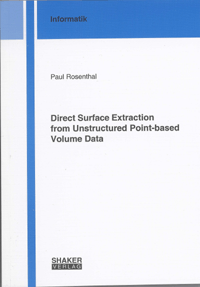
Reviews
Reviews

Paul Rosenthal
Direct Surface Extraction from Unstructured Point-based Volume Data
Review
Surface extraction is a standard visualization method for scalar volume data. Many algorithms for surface extraction from various data structures and types exist. However, for unstructured point-based volume data, where no topology or connectivity between data points is given, most approaches propose to reconstruct the scalar field over a grid and apply standard surface extraction techniques for the obtained grids. This work introduces a new method that directly extracts surfaces from unstructured volume data without three-dimensional mesh generation or reconstruction over a structured grid. The presented approach consists of two major processing steps: a geometry extraction step and a point-cloud rendering step. The geometry extraction step computes points on the isosurface by linearly interpolating between neighboring pairs of samples. The needed neighbor information is retrieved by approximating natural neighbors as provided by Voronoi diagrams. One presented approximation approach is the generation of a discrete Voronoi diagram with the aid of today´s graphics hardware. A second approach for approximating natural neighbors is the direct derivation from a space partitioning using a fed-tree. The approach is evaluated on several synthetic data sets and is significantly faster than previously developed algorithms while assuring nearly the same accuracy. To avoid rough isosurfaces in sparsely sampled regions, a level-set approach can be applied to the data before isosurface extraction. In contrast to existing level-set approaches, which operate on gridded data and mainly on regular structured grids, an approach is presented that directly computes level sets on unstructured point-based volume data without prior resampling or mesh generation. The practicality of this approach is shown on simulated smoothed particle hydrodynamics data. The output of the geometry extraction step is a point-cloud representation of the isosurface. The final rendering step uses point-based rendering techniques to visualize the point cloud. If a fast and interactive rendering is needed, an algorithm based on image-space operations is used. If the rendering should include photorealistic effects, a ray-tracing approach is preferable. The presented direct surface extraction algorithm for unstructured point-based volume data produces results of high quality. By applying the level-set approach in a preprocessing phase, it allows for a smooth yet correct surface extraction also for data sets with highly varying point density. The proposed methods are competitive with similar powerful approaches in terms of computation speed.
Am Langen Graben 15a
52353 Düren
Germany
Fri. 8:00 a.m. to 3:00 p.m.

